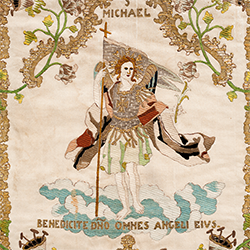
Dalmatic.
France (?), middle of the 18th c. – 3rd quarter of the 18th c.
Church of Saints Peter and Paul the Apostles in Vilnius.
18th c. Rococo colours and ideas of Classicism
The spirit of Rococo is particularly well reflected in eighteenth-century patterned silk fabrics from the weaving mills of France, above all Lyon, whose ornaments and colours were adopted by acupictors. The distinctive features of this style are light pastel colours, swirling flower garlands and diagonally meandering “rivers”. In the third quarter of the 18th century, the taste in decorative arts inclined towards classics with a predilection for clear architectural lines and a renewed interest in motifs of classical antiquity.
Dalmatics
The dalmatic is the central liturgical vestment of a deacon, the first order of ordained ministry. Canons and bishops wear the dalmatic under the chasuble, thus expressing the entirety of spiritual ordinance. Having become part of the liturgical costume in the 4th century, the dalmatic is derived from a long wide-sleeved ungirdled tunic worn in the Dalmatian province of the Roman Empire.
Embroidery with metal and silk threads
In the third quarter of the 18th century, a characteristic ornamental motif of Rococo silk fabrics is diagonally meandering “rivers” with little flower bouquets growing from them. This motif is also used in embroidered vestments. The ornament of “rivers of lace” plaited with flowers separates the figures embroidered with straight stitches.
Images of saints and floral ornaments
Angels and evangelists are depicted on the dalmatic: St. Matthew and St. Marc with seven archangels on the back, and St. John and St. Luke with seraphim and cherubim praising God on the front.

